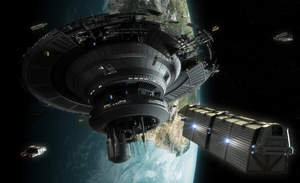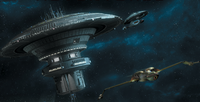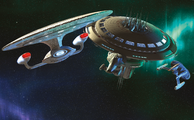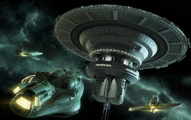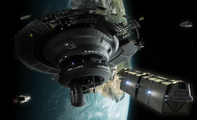User:McGig
Testing space for a lot of weird shit. Examples of most infoboxes are commented out in the source for this page. Look at your own peril. Also, Starbase Kickass and its associated shenanigans are Totally Canon. All events are real and undocumented as no one wants to admit they exist.
Narendra-class stations are a small to mid-size Federation starbase design that draws design inspiration from the likes of the far larger Spacedock-class stations. Designed to be assembled at manufacturing facilities within the Federation and then shipped in pieces to their final locations, the Narendra is essentially a kitset starbase designed for rapid deployment. If parts are in stock and available, a Narendra can be brought online in a new location in a matter of months, versus the years or decade it may take for a larger facility.
The intention was for a class of starbase to support Federation and Starfleet interests at a minimal cost in border sectors while not appearing as an escalation of assets to Federation neighbours who may take umbrage with a larger, more capable and fortified starbase.
Not without their teething issues upon initial activation, each Narendra station has contributed to the success of the next station. Upgrades for the first generation are being considered, though this too is likely in the form of kitset compartments being deployed to expedite the work on site.
Layout
The exterior of a Narendra-class is reminiscent of Starfleet's Spacedock-class starbases - a giant mushroom in space. The dorsal and ventral aspects of the station house large antenna farms, allowing the station to act as a regional communications relay and repeater as required. Dedicated shield generators protect the antenna farms from focused attacks.Designed for forward deployment, the Narendra-class carries a wide variety of defensive screens and weaponry. The surface of the station is dotted with phaser array strips, torpedo launchers and older phaser banks in certain locations to provide focused firepower to dissuade attacks along prescribed vectors.
Due to the size of the station, it is not intended or expected to hold off a dedicated attack, but to dissuade raids and rapid strikes as well as buy enough time for reinforcements to arrive.
The central core of the station houses the primary computer cores as well as truck access for vital services up and down the height of the station. Primary cargo lifts are located here as well to transport materials from the cargo bays to wherever they need to go.
Operations
The topmost levels of the station house the Operations division, as typical simply referred to as Ops. The station's primary command and control functions can be located here as well as offices for the station command staff. Offices and facilities abound for the Starfleet personnel aboard the station to perform their duties. Of note is a large auditorium built into each station, capable of hosting a hundred officers and guests in a single sitting. While a holdover of the original Narendra design requirements, the auditorium has become standard to the class and can function as a large scale briefing room to concert hall as required.
Galleria
One of the larger sections of the station the Galleria functions as the core of station life and commerce. Spread over multiple levels, with terraces descending down the levels, and wrapped around the station core, no two Galleria's are the same once the stations come online. Vendors and locals alike soon discover that the modular nature of the station is more amenable to modification across the Galleria, by design, and modifications are relatively simple to engage in. Bulkheads in the shopping area can be moved and the terraces shifted with a bit more work.
This tends to result in a quick fashion that each Galleria becomes its own architectural marvel. Restaurants, kiosks, salons, parlours and a variety of shops can and will be found across the Galleria as local enterprises take root. Most tend to be representative of the galactic neighbour they find themselves in, with encouragement to galactic neighbours to take part in order to help build report and economic ties as well as informal diplomatic channels.
Sciences
weird stuff
Personnel Quarters
Spread across multiple levels is the station's living quarters. Containing hundreds of single-, double-, and family-sized occupancy quarters as well as a handful of diplomatic suites. Recreation centres, game rooms, holosuites and a small selection of eateries, typically franchises from those found on the Galleria, can be located in this section of the station. Occupying a large space in the middle, wrapped around the station's support trunk, lies the station's arboretum, a full forty meters in height.
Medical
The medical section of the station contains facilities typically greater then more starships, but small and ill-equipped compared to larger stations. Six separate sickbays dominate this section of the station, each equivalent to a large starship, and specialising in its own field of medicine. Counselling offices, wards for a variety of species and isolation facilities accompany cutting edge, at the time of assembly, scientific labs, limited research facilities and cryogenic suspension facilities for cases that can't be resolved on-station.
A triage center lies in the heart of the station, with its own dedicated transporter facility and quick access to the primary sickbays. Each sickbay and the triage center all possess their own EMH, though with programming adjusted for their field of work.
Cargo Operations and Hanger Deck
stacky stuff and zoomy stuff
Engineering Complex
The Engineering Complex is located below the midpoint of the station and above the fusion generators. Engineering comprises four large levels and is interconnected via turbolifts, jefferies tubes and humble ladders as required. Engineering contains all the essential services for keeping a Narendra-class operational as well as housing backup computer cores and a hardened auxiliary command center commonly used for damage control but capable of full station control if required.
Fusion Generators
Primary power generation aboard the Narendra-class is achieved by three massive fusion generators located at the bottom of the station. Each generator plant contains four linked fusion reactors that collectively distribute plasma throughout the station. Two of the generator plants are enough to meet the station's power demands which allow for regular rotation in and out of service for maintenance purposes and hardware longevity. Each generation facility can be independently jettisoned from the station in an emergency.
Gallery
Narendra-class stations In-Play
- While not the largest or most capable of stations, like the larger Canopus or Spacedock facilities, the Narendra are a comfortable forward deployment designed to support the Federation's interest while not posing as a serious concern to the Federation's neighbours. More than adequate at defending themselves from local raiders or pirates, a serious threat to a Narendra would best be answered with a fleet garrison until local tensions deescalate.
- They serve as important border hubs for travel and commerce as well as providing essential services to outbound Starfleet vessels. While capable of providing servicing to Starfleet ships, outside of general maintenance it can best be described as sufficient to return to a more capable facility for proper repairs.
- Smaller than the Canopus facilities, a Narendra has a regular staff of a few thousand, with a capacity for the same again in regular civilian attendance. In an emergency, Narendra life support systems can accommodate 15000 people, but to call the situation cramped would be accurate.
